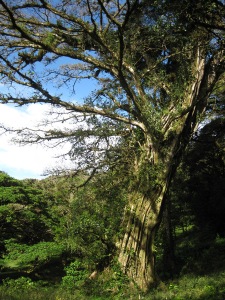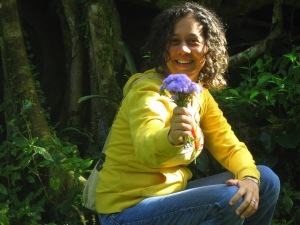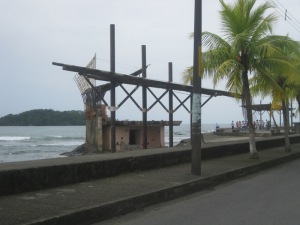You are currently browsing the tag archive for the ‘monkeys’ tag.

I’ve settled into my life as a dog nanny here in Monteverde. I’m sure that the three dogs, Chiqui, Betsy and Cutie Pie, must know I’m a dog lover, they can sense it, but they also must wonder once in awhile just who this crazy woman is that their family left them with. Bless their little muddy paws, they have driven me to the point of verbal insanity on too many occasions. I have taken it as my duty to add a little discipline to their lives and have made it my goal to break some of their bad habits by the time Veronica and Stuart return.

Cutie Pie, aptly named though I’ve taken to calling her La Negrita, is both a champion football player and a chronic chewer. Whereas the other dogs can be trusted to sleep in the bedroom at night, on their doggie beds, Cutie is confined to the main room of the house where most chewable things have been removed or already chewed up. In the exactly three minutes I helped Veronica carry her suitcases to the driveway to meet the car coming for her when she left last week, Cutie had managed to chew a corner of the wooden arm of the chair she sleeps in. So then I felt that I had to take the whole chair out of the room, along with everything else. This just seems crazy to me. A dog, even a very cute one, can certainly learn better habits. So I keep a keen eye on her and am all over her when I see her chewing. I also smeared hot chili all over the arm of the chair to deter the behavior. She seems to like it.
Betsy, the youngest of the three, maybe seven months old, is a barker and a sharp one at that. If something gets her started, the barking goes on till I wanna scream which, of course, only adds to the noise. So I keep trying the dog-whisperer techniques (a show I’ve watched when in houses with cable TV), and bit by bit Betsy is understanding that she can do a bit of barking but when I get that crazed look in my eyes and my voice rises, it is time to stop.

Being a pack of three, if one gets going, they all do. La Negrita is the first to stop, and the elder, Chique, is older and wise enough to back off quickly, but Betsy, well, let’s just say that I hope she ages a lot in the next few weeks. I don’t want to insinuate that I don’t love these little dogs – they greet me with all that canine love when I walk up the path, they look at me with as much tenderness as any man I’ve ever known (well, maybe), and they are quite entertaining when not chewing and barking and jumping up so they can drag their claws down my now-bruised thighs.
My best investment in 2009? A thousand colones ($2) for a water spray bottle. Appropriate technology – the only weapon I’ve used in the struggle to great effect.

Fortunately I’ve had company here – Marilyn and Gerardo from San Ramon/Sarchi were here for a couple days and then Roberto came up from the Caribbean to see Monteverde. I’ve decided that it is a tribal thing going on here – when the dogs outnumber me, they have the definite cultural advantage. However when other humans are here, we collectively have more power. Bit by bit, the dogs are learning some manners. Less things are being chewed, the barking is slowing down. We’ve all joined in playing soccer with them – La Negrita is a great ball handler and Betsy is nothing if not enthusiastic and will actually bring the ball back once in awhile. An hour of soccer helps to wind these little energizer-bunnies down.

When not at home doing the canine shuffle, I’ve been doing the book selling thing all over the area – the local stores all needed more copies of Walking with Wolf. Wolf and I can sell well if seated at the entrance to the Reserve when the tour groups come out of the forest mid-morning. It is fun to sit in the often drizzly, windy weather (we retreat to one of the restaurants when it is really bad) and even nicer on the sunny days under the beautiful tree canopy, with a variety of bird and animal sightings ranging from black guans and quetzals to pizotes, monkeys and olingos. We’ve had wonderful conversations with interested tourists and I’ve made some great contacts for possible future presentations of the book in North America.

People report seeing quetzals in the forest but the blue-crowned motmots have been here, there and everywhere. They are a beautiful, simpler alternative to the elegant, elusive quetzal, being one of the friendlier and consistent birds around.

I’d really have to say they are more deserving to be designated the Monteverde mascot than any other bird.
I was at a local restaurant to see the inauguration last Tuesday but had to meet the bus at the same time so I missed Obama’s speech (but not the fashions – loved Michelle O’s dress & Aretha’s hat). I’ve seen some lines from it which made me think it was a beautiful beginning to the next stage of life in the USA and thus the world. I’m actually glad I’m not in North America during this period – here on the green mountain I miss so much of what is going on internationally by not having steady access to media and I would just as soon believe that things are going well and not know the details. I’ll be back in the thick of it again soon enough.

Instead I’ve been wandering around the dusty roads and back trails of Monteverde, filling my soul with the magic of the woods while showing my visitors some of the local highlights. My spiritual center here is the bullpen up on Campbell’s land, a medieval St. Augustine pasture hidden in an open forest where the gigantic trees left standing can stretch their branches wide. Roberto appropriately renamed it the wolfpen when I explained that Wolf had been the main traveler over the years through this hidden park-like land.
The other day Wolf and I stopped in at Historica Monteverde. This was the dream of Lindi, his former daughter-in-law who passed away two years ago after a long battle with health issues, cancer being the ultimate victor. We talk about Lindi in Walking with Wolf – she was married to Tomás Guindon, Wolf and Lucky’s second son, and was always a strong presence in the Monteverde community. I knew her from early in my time here, and got to know her better when I lived with a university group from Evergreen College in 1995 and she was the Spanish and culture instructor. Lindi was a tall statuesque woman whose robust physicality didn’t suit her chronic illnesses.

The last time I visited with her was a few months before her death, before I returned for Canada, and she was still fighting but already at peace with whatever eventual ending was being designed for her script. Since I had had cancer, she appreciated the frankness with which I spoke (being quite direct herself), but of course, I’m a survivor. It was already clear that she probably wasn’t going to be much longer. One of the things that held her interest until the end was the idea of building this museum of Monteverde artifacts on a corner of her property. Although she didn’t live to see its completion, her daughter, Kayla, saw that it was finished and went on to celebrate its opening at the end of August this past year.
At the time, I had a beautiful email from my friend Mary Stuckey Newswanger about what a wonderful day it was, despite torrential rains, when the community gathered to honor the completion of Lindi’s dream, the history of this special place, and the spirit that keeps Monteverde whole. One of the highlights that day, as well as for me on this one, was the very large model map of Costa Rica, apparently the largest in the country. It sits in a pool of water, representing the oceans, surrounded by a fence that spectators can gather up to. A slide show with images collected from all over this beautiful land is punctuated by lights on the topographically-correct map that show where the images are located.

At the end of the show the map’s volcanoes, those magical cones of fire and brimstone that wander down the spine of Central America, are lit up like flowing lava and smoke gushes out. When a door was opened to help clear out the smoke, the haze lifted and swirled and flew off to the horizon, just as you could watch sitting in La Fortuna after the rumble and roar of the Arenal volcano has passed.
So good for you, Lindi, but also for Kayla and Robin and everyone else who helped bring this dream to its completion. As someone said to me recently, the fifty-plus year history of Monteverde is expansive, covering about 200 years of progress – it was very much a pioneering community being cut out of the forest in 1951 and is now a pretty modern one regularly receiving international guests and linked worldwide through technology in 2009.

The other day I took this photo of the various methods used for transporting milk to the dairy plant each morning – from the original oxen and cart to the big shiny modern tank truck, all lined up, waiting their turn to unload the stainless steel jugs of fresh milk.

Fortunately you can still get held up in a bovine traffic jam in downtown Monteverde. Even with all the changes that have come to the mountain and the immense pressures put on the community by development, Monteverde holds it own when it comes to its charms.


Learning how to get along, adapting to change, realizing dreams and appreciating the beauty around us – and bringing a little order to the chaos – the continuing themes of life as it plays out on the green mountain.









































